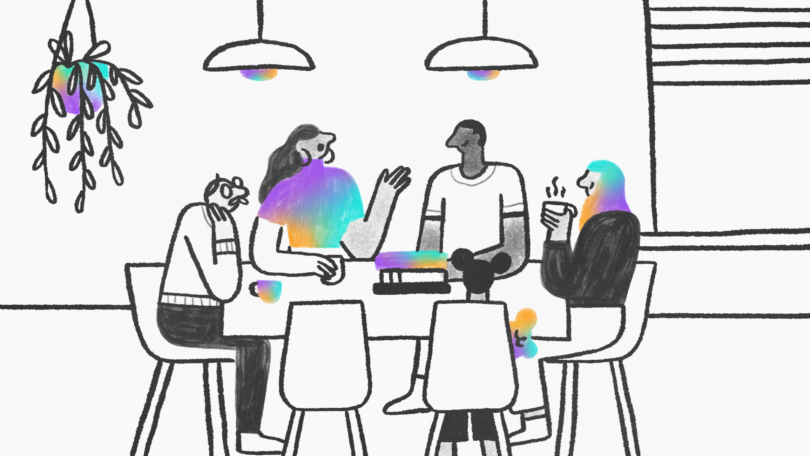Tips on how to have a respectful conversation about race
Heralded as one of the nation’s most strategic thinkers, Waikinya J.S. Clanton has served as senior advisor to some of the country’s top political and social impact leaders. With more than a decade of executive, political and community engagement experience, Clanton provides strategic guidance on matters of race, culture, and community to leading political organizations and social impact firms around external affairs and third-party engagements. Waikinya is a certified strategic diversity and inclusion professional. Follow her on Twitter @WJSClanton or LinkedIn in/WaikinyaClanton.
Talking about race is hard and complex. It forces one to see beyond themselves in an effort to see someone else. Hate has no place in our communities and conversations about thoughtful approaches to racial injustice, healing, and belonging are long overdue. As neighbors, we must choose to see and value each other — our similarities, our humanity, and our unique and brilliant differences.
Recent events in America have made it all too clear that we have to get comfortable having uncomfortable, but civil and respectful, conversations. Attention to inequities around racial justice have been on an upward swing beginning with the murders of Trayvon Martin, Michael Brown, Tamir Rice, Sandra Bland, Philando Castille, and others; to only be intensified by the killings of George Floyd, Breonna Taylor, and Ahmad Arbery last year. It is not by coincidence that less than a year later, Derek Chauvin stands trial for the murder of George Floyd less than 10 miles from where 21-year-old, father, Daunte Wright was slain at the unlawful will of law enforcement.
As our country seeks to move toward racial healing and reconciliation, we are reminded of just how much work remains. We must address how racial bias becomes hate, and hate becomes fatal. It’s time we talk about race.
Change starts in the neighborhood, and Nextdoor is a place to spark a conversation with neighbors from all backgrounds. As part of their anti-racism efforts aimed at bolstering safe, civil conversation on race, AARP compiled the following list to consider when having a community conversation.
1. Check your own bias
We all approach conversations about race through a different lens. “You really bring your personal experience and the way that you have been forced to walk through this lifetime … to the table when you have conversations about race,” says Janerick Holmes, racial justice network associate director at the Shriver Center on Poverty Law.
No matter what race you are, that lens will include some prejudice, so be mindful of the biases you hold, says Holmes. Your age and the time period in which you grew up may also affect how you see the role race plays in society, and that has changed throughout the decades. It’s important to think through your ideas before beginning conversations, but also to remain open to hearing other perspectives.
2. Set guidelines, boundaries, and goals
Some of the fear and discomfort around conversations dealing with race stem from uncertainties about where a conversation may lead and how people may react. Setting clear guidelines, boundaries and goals can be useful. Those strategies can be as simple as allowing one person to speak at a time or agreeing that conversations are confidential.
Clinical psychologist Erlanger Turner suggests creating a safe space for people to feel a full range of emotions. “Sometimes when people start to get angry, you want them to not be angry. That’s not fair to anyone,” says Turner. “These are natural emotional responses so it’s unhealthy to try to turn those feelings off.”
3. Start on common ground
Try finding a book, podcast, news article or movie about race that you have both seen or heard and center the conversation on that. Another idea is for two people to take an implicit association test, which is used to measure a person’s attitudes and beliefs about various topics including race, weight, and sexuality, and discuss your results.
4. Turn to facts
Talking about race may turn emotional and, while emotions matter, facts can be a useful way to examine conversations about structural and institutional racism. This doesn’t mean there won’t be disagreements, but start with data, such as the racial discrepancies in pregnancy-related deaths, for example, or rules and regulations that single out people of color, such as workplace or school bans on specific hairstyles, as a basis to ground conversations.
5. Agree to disagree when necessary
Know that conversations about race may not always end in agreement. In Liles’ case, he and his friend have come to a place where they agree to disagree. “Some people aren’t trying to hear it,” Holmes adds. “If somebody does not want to talk about race, if somebody is just completely unmovable then maybe that’s kind of where they want to be.”
6. Use “FFF” statements
Expressing your feelings on race and how they’ve evolved over time can evoke strong emotions. Clinical psychologist Beverly Daniel Tatum, recommends using “FFF” statements — express yourself by saying “I felt … I found out … and so now I feel.” This strategy can be helpful because the focus is on your feelings, so statements are less likely to provoke defensiveness.
As an example, Tatum says some people might feel conversations about race are frowned upon and it is better to be color-blind. But that approach may evolve into an effort to be anti-racist, which Tatum says means acknowledging and understanding racism and then actively working to dismantle it.
7. Actively listen
Many of us might admit to at one time or another being so focused on our next point in a conversation, that we barely listen to what the other person is saying.
Especially in conversations about race, it can be easy to listen for — and key in on — certain hot-button issues and use them as an excuse to get defensive or cut people off. “You’ve got to resist that and let people finish their thoughts,” Holmes says.
The point the person is making may be unexpected, and you’ll miss it without listening closely. “What if something beautifully articulated is coming at the end, where you will begin to see this person in a completely different light?” he adds. “You got to just let those moments happen.”
To begin a conversation about race in your neighborhood, be sure to check out AARP’s conversation starters and Nextdoor’s anti-racism resources. Prepare yourself – emotions may run high, but it is imperative that you remain thoughtful, open, and respectful in your dialogue.
To connect with your local neighborhood, please login at nextdoor.com.


What I love about these tips the most is that they are scientificly based that are tried and true solutions! Thanks for writing such an impactful pieace that we can use to cause real change.
Thank you for these resources. I was surprised ( as I suppose most people are) when I took the bias test. It showed that I have a preference for white people ( my own race). I am willing to accept my bias and work toward something better.